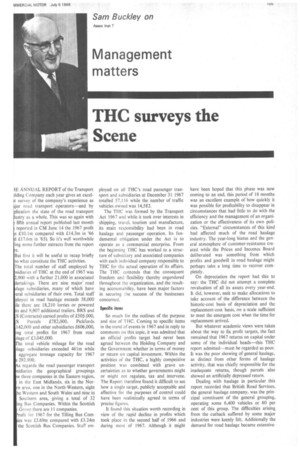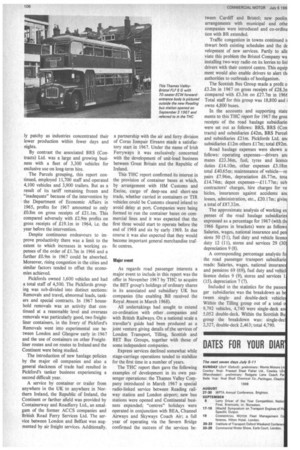THC surveys the
Page 107

Page 108

If you've noticed an error in this article please click here to report it so we can fix it.
Scene
4E ANNUAL REPORT of the Transport plding Company each year gives an excelt survey of the company's experience as jor road transport operators—and by plication the state of the road transport ustry as a whole. This was so again with fifth annual report published last month reported in CM June 14 the 1967 profit s £10.1m compared with £14.3m in '66
• £17.6m in '65). So it's well worthwhile ing some further extracts from the report e.
But first it will be useful to recap briefly to what constitute the THC activities. The total number of staff employed by sidiaries of THC at the end of 1967 was • 900 with a further 21,000 in assoFiated ertakings. There are nine major road lage subsidiaries, many of which have eral subsidiaries of their own. Total staff ployed in road haulage exceeds 38,000 lie there are 18,210 lorries or powered ts and 9,907 additional trailers. BRS and S (Contracts) earned profits of £505 poo, S Parcels £782,000, Pickfords 142,000 and other subsidiaries £606,000, ing total profits for 1967 from road lage of £3,045,000.
he total vehicle mileage for the road age subsidiaries exceeded 461m while aggregate tonnage capacity for 1967 292,900.
s regards the road passenger transport sidiaries the geographical groupings w three companies in the Eastern region, in the East Midlands, six in the Norn area, one in the North-Western, eight he Western and South Wales and nine in Southern area, giving a total of 32 ing Bus Companies. Within the Scottish Group there are 11 companies.
rofit for 1967 for the Tilling Bus Comics was £3.69m compared with £3.24m the Scottish Bus Companies. Staff em ployed on all THC's road passenger transport and subsidiaries at December 31 1967 totalled 57.116 while the number of traffic vehicles owned was 14,582.
The TUC was formed by the Transport Act 1967 and while it took over interests in shipping, travel, tourism and manufacture, its main responsibility had been in road haulage and passenger operation. Its fundamental obligation under the Act is to operate as a commercial enterprise. From the beginning THC has worked to a structure of subsidiary and associated companies with each individual company responsible to THC for the actual operation of its affairs. The THC contends that the consequent freedom and flexibility thereby engendered throughout the organization, and the resulting accountability, have been major factors in securing the success of the businesses concerned.
Specific items So much for the outlines of the purpose and size of THC. Coming to specific items in the trend of events in 1967 and in reply to comments on this topic, it was admitted that an official profits target had never been agreed between the Holding Company and the Government whether in terms of money or return on capital investment. Within the activities of the THC, a highly competitive position was combined with grave uncertainties as to whether governments might or might not regulate, tax and intervene. The Report therefore found it difficult to see how a single target, publicly acceptable and effective for the purposes of control could have been realistically agreed in terms of precise figures.
It found this situation worth recording in view of the rapid decline in profits which took place in the second half of 1966 and during most of 1967. Although it might
have been hoped that this phase was now coming to an end, this period of 18 months was an excellent example of how quickly it was possible for profitability to disappear in circumstances that had little to do with the efficiency and the management of an organization or the effectiveness of its own policies. "External" circumstances of this kind had affected much of the road haulage industry. The year-long hiatus and the general atmosphere of customer-resistance created while the Prices and Incomes Board deliberated was something from which profits and goodwill in road haulage might perhaps take a long time to recover completely.
On depreciation the report had this to say: the THC did not attempt a complete revaluation of all its assets every year-end. It did, however, seek to make allocations to take account of the difference between the historic-cost basis of depreciation and the replacement-cost basis, on a scale sufficient to meet the emergent cost when the time for replacement arrived.
But whatever academic views were taken about the way to fix profit targets, the fact remained that 1967 returns on capital under some of the individual heads—this THC report admitted—must be regarded as poor. It was the poor showing of general haulage, as distinct from other forms of haulage activity, that was chiefly responsible for the inadequate returns, though parcels also showed an artificially depressed return.
Dealing with haulage in particular this report recorded that British Road Services, the general haulage company, was the principal constituent of the general grouping, operating some 6,400 vehicles or 60 per cent of this group. The difficulties arising from the cutback suffered by some major industries were keenly felt. Additionally the demand for road haulage became extensive ly patchy as industries concentrated their lower production within fewer days and nights.
By contrast the associated BRS (Contracts) Ltd. was a large and growing business with a fleet of 3,300 vehicles for exclusive use on long-term hire.
The Parcels grouping, this report continued, employed 11,700 staff and operated 4,100 vehicles and 3,900 trailers. But as a result of its tariff remaining frozen and "inadequate" because of the intervention by the Department of Economic Affairs in 1965, profits for 1967 amounted to only £0.8m on gross receipts of £21.1m. This compared adversely with £2.9m profits on gross receipts of £19.1m in 1964, i.e. the year before the intervention.
Despite continuous endeavours to improve productivity there was a limit to the extent to which increases in working expenses of the order of £1.7m in 1966 and a further £0.9m in 1967 could be absorbed. Moreover, rising congestion in the cities and similar factors tended to offset the economies achieved.
Pickfords owned 1,600 vehicles and had a total staff of 4,500. The Pickfords grouping was sub-divided into distinct sections: Removals and travel, abnormal loads, tankers and special contracts. In 1967 household removals was an activity that continued at a reasonable level and overseas removals was particularly good, two freightliner containers, in the livery of Pickford's Removals went into experimental use between London and Glasgow early in 1967 and the use of containers on other Freightliner routes and on routes to Ireland and the Continent were being studied.
The introduction of new haulage policies by the major oil companies and also a general slackness of trade had resulted in Pickford's tanker business experiencing a second difficult year.
A service by container or trailer from anywhere in the UK to anywhere in Northern Ireland, the Republic of Ireland, the Continent or farther afield was provided by Containerway and Roadferry Ltd., an amalgam of the former ACCS companies and British Road Ferry Services Ltd. The service between London and Belfast was augmented by air freight services. Additionally. a partnership with the air and ferry division of Coras Iompair Eireann made a satisfactory start in 1967. Under the name of Irish Ferryways it was exclusively concerned with the development of unit-load business between Great Britain and the Republic of Ireland.
This THC report confirmed its interest in the provision of container bases at which, by arrangement with HM Customs and Excise, cargo of deep-sea and short-sea trade, whether carried in containers or TIR vehicles could be Customs cleared inland to avoid delay at port. Companies were being formed to run the container bases on commercial lines and it was expected that the first three would start to operate before the end of 1968 and six by early 1969. In due course it was also expected that they would become important general merchandise traffic centres.
Major event As regards road passenger interests a major event to include in this report was the offer in November 1967 by THC to acquire the BET group's holdings of ordinary shares in its associated and subsidiary UK bus companies (the enabling Bill received the Royal assent in March 1968).
All undertakings had sought to extend co-ordination with other companies and with British Railways. On a national scale a traveller's guide had been produced as a joint venture giving details of the services of London Transport, Tilling, Scottish and BET Bus Groups, together with those of some independent companies.
Express services declined somewhat while stage-carriage operations tended to stabilize for the first time in a number of years.
The THC report then gave the following examples of development in its own passenger operations: the Thames Valley Cornpany introduced in March 1967 a special radio-linked service between Reading railway station and London airport; new bus stations were opened and Continental business expanded; "centres" holidays were operated in conjunction with BEA, Channel Airways and Skyways Coach Air; a full year of operating via the Severn Bridge confirmed the success of the services be
tween Cardiff and Bristol; new poolin arrangements with municipal and othe companies were introduced and co-orelina tion with BR extended.
Traffic congestion in towns continued b thwart both existing schedules and the de velopment of new services. Partly to alle viate this problem the Bristol Company wa installing two-way radio on its lorries to linl drivers with their control centre. This equip ment would also enable drivers to alert th■ authorities to outbreaks of hooliganism.
The Scottish Bus Group made a profit o £3.2m in 1967 on gross receipts of £28.3n compared with £3.3m on £27.7m in 196E Total staff for this group was 18,800 and i owns 4,800 buses.
In the accounts and supporting state ments to this THC report for 1967 the gros receipts of the road haulage subsidiarie were set out as follows: BRS, BRS (Con tracts) and subsidiaries £42m, BRS Pared and subsidiaries £21m. Pickfords Ltd. an( subsidiaries £12m others £17m; total £92m.
Road haulage expenses were shown a follows: operating expenses—drivers an mates £23.36m, fuel, tyres and licenct duties £14.10m, other expenses £3.18m total £40.65m; maintenance of vehicle—re pairs £7.96m, depreciation £6.77m, tota £14.74m; depot expenses—£11.77m; sub contractors' charges, hire charges for ve hides, insurances against accidents an losses, administration, etc., £20.17m; givin a total of £87.32m.
The approximate analysis of working ex penses of the road haulage subsidiarie expressed as a percentage for 1967 (with th 1966 figures in brackets) were as follows Salaries, wages, national insurance and pe sions 50 (51), fuel duty and vehicle licenc duty 12 (11), stores and services 29 (30 depreciation 9 (8).
A corresponding percentage analysis fo the road passenger transport subsidiarie reads: Salaries, wages, national insuranc and pensions 69 (69), fuel duty and vehicl licence duties 9 (9), stores and services 1 (15), depreciation 7 (7).
Included in the statistics for the passe ger subsidiaries was the breakdown as tween singleand double-deck vehicle Within the Tilling group out of a total 9,792 vehicles, 4,740 were single-deck an 5,052 double-deck. Within the Scottish Bu group the breakdown was: single-dec 2,327, double-deck 2,463; total 4,790.
























































































































































